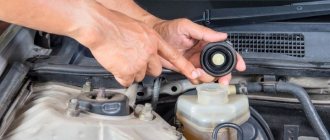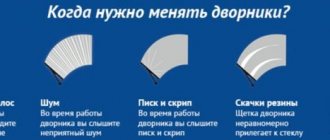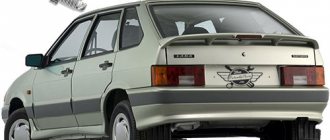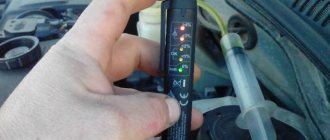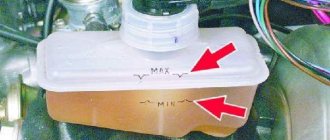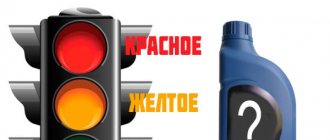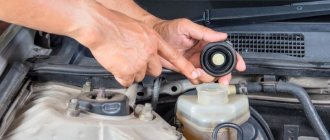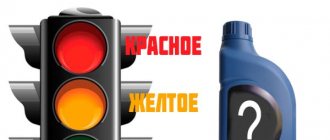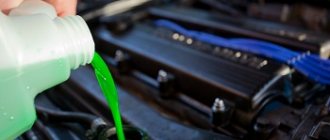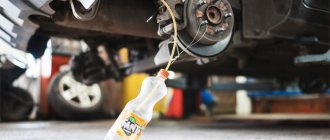Brake fluid is one of the most important service materials used in a car. The efficiency and reliability of the brakes directly depends on its quality.
Car manufacturers recommend changing brake fluid at certain intervals - usually once every two years (every 30-40 thousand kilometers). Such regulations were established as a result of many years of testing and calculations, so it is difficult to challenge them.
However, many drivers simply do not pay attention to the recommendations in the service book and do not pay due attention to the brake fluid - especially if no problems are observed in the operation of the brake system.
Let's see if those who do not consider it necessary to change the brake fluid on time are right. Let us name the signs of “aging” of the material and the rules for its independent replacement.
Content
- Why is replacement necessary?
- Replacement frequency Standard replacement periods
- Urgent replacement rates
The main function of brake fluid (BF) is to transmit the force of pressing the brake pedal to the working cylinders of the vehicle braking system. The correct operation of the vehicle and the safety of those in the cabin - the driver and passengers - depend on its characteristics. For trouble-free operation of the braking system, it is necessary that the brake fluid meets a number of requirements. These include the following:
- high boiling point;
- low viscosity at low temperatures;
- chemical inertness;
- low hygroscopicity.
Brake fluid replacement period when visiting a service station
When the safety of car operation is at stake, it is better to turn to professionals. The periodicity of updating the working solution depends both on the manufacturer’s recommendations and on other factors. An experienced auto mechanic will accurately assess the condition of the brake fluid.
You can find a suitable car service on the Uremont.com aggregator. Here, by filling out the online application form, you will receive responses from partner technical centers in a matter of minutes.
In addition, the service provides the opportunity to contact professionals directly through chat (for example, find out how much services cost), user reviews and ratings, an interactive map indicating workshop addresses and other tools useful for car owners.
Why is replacement necessary?
The main reason that brake fluid has to be changed over time is that it loses its original performance characteristics. This is caused by the following processes:
- absorption of moisture. Brake fluids have a certain hygroscopicity. During operation, the vehicle's braking system constantly heats up and cools down, resulting in condensation forming in it. The latter gets into the brake fluid and accumulates in it. When the moisture content increases to 3.5%, the boiling point decreases by one and a half times, which leads to incorrect operation of the brakes or failure of the entire system;
- pollution. It is caused by wear of rubbing surfaces and leaching of metal particles, corrosion, seals, etc. into the brake fluid. Contamination leads to clogging of the braking system channels and accelerated wear of its parts and components. Dirty brake fluid can be easily identified visually: it becomes darker.
How to check the condition of the fluid?
A good indicator of the condition of the brake fluid is its color.
Usually it has a light yellow tint, less often – red. Preservation of color is a sign of the normal state of the liquid. Turbidity, sediment or dark particles indicate an unbalanced additive package. If this fluid is not replaced, brake cylinder parts may fail.
More accurate diagnostics of brake fluid is carried out using special testers. They look like small boxes with probes. The tester is immersed in the liquid, the probe heats up and determines its temperature. The information is displayed on a special display in the form of the inscriptions “urgently replace”, “it is advisable to replace” or “everything is in order”.
This check takes less than a minute. The measurement error is very small (about 3%). The testers themselves are available at any auto parts store.
It's even easier to use special litmus strips. They allow you to assess the degree of contamination of the brake fluid with tiny copper particles from system parts.
The indicator strip is lowered into the expansion tank for 30-60 seconds, after which it is removed and compared with the samples on the packaging. Based on the description of the colored marker, it will become clear whether it is time to change the fluid.
Replacement frequency
The time after which the vehicle should be changed depends on its category, driving style, operating conditions, etc.
Standard replacement times
For the most budget products of the DOT-3 class they are 1.5 years, for DOT-4 – 2 years, for DOT-5 – 4–5 years. The indicated times are average and are based on standard road conditions and a relaxed driving style. Many manufacturers indicate terms once every two years, for premium cars - once every 1 year. Under difficult operating conditions, for example, when driving on mountain roads or with frequent braking, changing the brake fluid may be necessary much earlier.
Urgent replacement rates
The main signs that the fuel tank should be replaced immediately will be:
- recessed brake pedal during intense driving;
- The brake fluid is dark, cloudy, or has sediment.
Indications for a complete and immediate replacement of the vehicle are also long-term downtime of the car or repair of its brake system. If the car was purchased on the secondary market, it is also recommended to replace the brake fluid. Many manufacturers advise doing this once every 2-3 years. It is during this period that the water content in the liquid increases to 3.0-3.5%, which is the maximum permissible according to DOT standards. Replacement intervals may vary. It is recommended to measure the moisture content of the brake fluid every 6–9 months. This can be done during service or independently, using a special electronic tester.
How often should I change
How long does it take to change the brake fluid to prevent trouble? Manufacturers recommend doing this regularly, after driving only 30-40 thousand miles. Or in two years, if you haven’t driven that much in that time. The exception is sports and premium classes of cars. After what mileage is replacement of the TJ required for them? For these machines, the period of use of the TZ is only 10-15 thousand mileage, or a year of operation, respectively.
In cars with abs, the frequency of replacement is the same as in cars without it. Since this system does not affect the service life of the fluid.
It is allowed to add TJ with the same type of liquid and even mix the same type of liquid. However, mixing may result in sediment caused by incompatible brands or manufacturers' formulations, which not only settles inside the reservoir but also clogs the system, impairing the performance of the brakes.
Is it possible to add brake fluid?
While topping up the fuel fluid instead of completely replacing it is acceptable, it is not recommended. If you mix contaminated brake fluid containing 3.0-3.5% moisture with new brake fluid, this will not completely restore its properties. When topping up, the performance characteristics of the fuel tank will only improve slightly and will not fully meet safety standards. Therefore, it is much more economical to make a complete replacement. However, if for some reason this cannot be done, you can limit yourself to a one-time topping up. It should be borne in mind that only products on the same basis can be mixed. One of the best decisions for a car would be to purchase SINTEC EURO DOT-4. This brake fluid is a unique development of the company and is fully compatible with all DOT-3, DOT-4 brake fluids, as well as other Russian products made on the basis of factory specifications.
Which TCs can be mixed
If we talk about whether it is possible to mix brake fluid from different manufacturers, then remembering compatible brake fluids is very simple. Today there are several brake standards, which are designated by DOT markings:
- DOT 3 is a glycol fluid that is made from polyethylene glycol and polyester. Used for low-speed cars, in the brake system of which the operating temperature does not exceed 150 degrees. This formulation can be mixed with a similar DOT4 glycol fluid.
- DOT 4 is a glycol composition that contains additional additives. Boils at higher temperatures (200-230 degrees). Used for high-speed vehicles. This composition can be mixed with the previous one.
- DOT 5 is a silicone based liquid. Used for sports cars. The boiling point reaches 260 degrees. Mixing such TJ with any glycol composition is strictly prohibited.
- DOT 5.1/ABS is a glycol fluid that is used exclusively for cars with an ABS system. Such compositions also cannot be mixed with other pillboxes.
As you can see, “mixes” can only be made from DOT 3 and DOT 4. The manufacturer is not so important, since these compositions have similar characteristics and bases.
How to properly replace a TJ
Ideally, brake fluid replacement should be performed at a technical center. All operations, including flushing the system, are carried out automatically. But many drivers do the work themselves. In this case, each circuit is pumped and washed alternately with the addition of fuel fluid to the tank. The main thing you should pay special attention to is to prevent air from entering the system. Replacing brake fluid includes several steps:
- the tank is opened, then the fittings are unscrewed, a hose or vinyl tube is pulled onto them;
- The fuel fluid is completely pumped out of the system through the tube using the brake pedal;
- new fluid is poured into the tank until it begins to pour out of the hose;
- the fittings are tightened, the fuel fluid is pumped by pressing the pedal to remove air from the system;
- the hose is removed, the cover is installed in its original place and fixed.
If you are not sure that you can make the replacement correctly, it is better to contact a service center.
Bleeding the brakes
To perform this procedure, you need to press the brake 5-6 times, after which the pedal is clamped. At this time (with the brake pressed), you need to unscrew the fitting on which the hose is located. As soon as your partner informs you that the pedal has gone to the floor, tighten the fitting.
It is recommended to repeat this operation until air stops escaping.
When replacing a brake fluid on their own, many car enthusiasts have a question: how to find out what kind of brake fluid is filled and whether it is possible to mix different compounds. In the first question, it is better not to guess and not try to determine the composition by taste, color or smell. It is better to change the fluid completely and attach a label from the bottle with the composition to the inside of the hood (or any other place).
As for the possibility of mixing, here, as in everything related to automotive fluids, it all depends on the basis of the composition.
Manufacturer's recommendations
Most manufacturers suggest replacing it every two years. On the other hand, as far as distance is concerned, 40,000 kilometers is the milestone after which you will need a replacement. Please remember that each manufacturer has specific requirements that you should read in your user manuals.
If you do encounter any doubts or misunderstandings, it is never too late to consult an automobile expert. Always remember to undergo maintenance as your safety is entirely in your hands.
Most people know that routine car care includes an inspection. Squeaky brakes attract attention, as does a car that takes longer to stop than is usually necessary. But brake lube? Many car owners forget that it even exists. However, proper maintenance of your vehicle includes taking care of this essential fluid.
If you have questions about this oil, you are not alone. My workshop clients often ask whether the fluid needs to be changed, and if so, how often it should be done. Here are some tips and facts to answer the most frequently asked questions.
Self-replacement without assistants
Usually they buy TJ with a capacity of 1 liter. When replacing for passenger cars, 0.55 liters is usually used, regardless of the size of the car, cross-country ability, or the presence of ABS.
The most commonly used grade is DOT-4. This is the most popular product. They change it as a result of its high hygroscopicity. DOT-4 actively absorbs moisture from the air, and therefore loses its characteristics.
Reminder!
TJ should not be stored in an open container for a long time; it retains its quality for only two years!
Before replacing, first install the car on an inspection hole or overpass. There must be free access to the place to drain the waste material and then fill the tank. You need easy access to the brake cylinders of four wheels.
Adaptations
- Key for 8 or 10.
- Bulb or syringe.
- A piece of hose – 4 pcs.
- Collection container – 4 pcs. Plastic bottles will do.
- Rags.
Step-by-step instruction
The process is:
- Find the brake master cylinder and brake fluid reservoir in the car.
- Then you need to unscrew the tank cap.
- Pump out the remaining liquid from the tank using a bulb or syringe.
- Unscrew the fittings from all brake devices on the wheels.
- Place the end of a transparent hose onto the valve fitting, and lower the other end into a plastic bottle. The hoses must fit tightly.
- Make sure that any remaining liquid flows through the hoses into all bottles.
- It is necessary to monitor the drainage and gradually add fresh liquid to the tank. Filling should prevent the tank from drying out.
- If the bottle on the front left wheel is filled to approximately 200 ml, you should tighten the fitting on this cylinder. The procedure is repeated on all wheels. On the rear, filling can reach 250 ml.
- You need to screw in the fittings after you are sure that the fresh mixture has begun to flow into the bottle.
- Check the tightness of the tightened fittings. Put on the caps. Check the filling level.
- After an independent change, pumping is required.
Basic mistakes
- Mix different TJs.
- Do not allow the level to drop below the minimum. That is, to prevent air from entering the system.
- Do not raise the pressure in the tank more than 0.8 atmospheres, otherwise it may explode.
Reminder! For regular replacement, you need to use those brands of products that are recommended by the car manufacturer. The rule says you can't mix different classes! However, it is possible to mix DOT 3 with DOT4 to improve the quality. But you can’t pour DOT 3 into DOT4.
How to know when it's time to change the brake fluid
In addition to following the general fluid replacement schedule, it is necessary to periodically evaluate its condition. To do this, just look into the brake fluid reservoir by unscrewing the cap. In addition, in many car models the tank is translucent, and there are risks on it for maximum and minimum fluid levels. Using them you can easily determine whether there is a need to add liquid.
However, it is worth inspecting the liquid inside the tank as well. Such an inspection is useful because you can notice its visual changes - a change in color, the presence of sediments and impurities, etc.
Checking the brake fluid in the reservoir
As the vehicle is used, the brake system may become depressurized over time. As a result, air may enter the system, and the liquid itself may leak out. Fluid leakage is possible from under the GTZ seals, brake pipes and from the brake booster.
If you notice that your brake fluid has changed color, become cloudy, or has sediment, then it is better to completely replace it. In this case, the car cannot be operated until new fluid is added. Normally, brake fluid should be clear, homogeneous and without sediment.
On the left is new, clean brake fluid, on the right is old, long-used brake fluid.
In addition to personal visual inspection, car repair shops can check the quality of brake fluid with a special tester. This tester determines the percentage of water content in a liquid. If this value turns out to be critical, the tester will show on the display the need to replace the brake fluid. Water content above 3% is already considered unacceptable.
Checking the brake fluid with a special tester
Color plays a huge role
It is recommended to visually inspect the mixture every two years or so. In case the product does not appear clear, replacing the mixture will be necessary. Visit a mechanic or go to a service center if the paint is rusty or appears dirty.
Brake oil contamination occurs due to the accumulation of moisture in the environment. The answer to how often you should change your brake lubricant is simple, trust your eyes more than others recommend.
Signs of replacement
When the pedal loses its effectiveness or grip. In fact, the braking mechanism of a car is highly dependent on the hydraulic pressure system. It is brake oil that helps maintain hydraulic pressure. Replace the brake fluid if the brake pedal presses more than normal.
If it becomes dirty, the brakes may become softer when filled with air. If you feel like you're losing control of your brakes, changing your brake compound is all you need.
Replacement instructions
To change the fluid in the brake system of the vast majority of cars, it is enough to have simple tools and devices:
- jack and wrench for wheel bolts (nuts);
- an 8–10 mm socket wrench for unscrewing the drain fittings on the working cylinders;
- a transparent tube of the same size and a plastic bottle;
- medical syringe with a volume of 20 cm3.
Working conditions: a garage or a flat area on the street. When the time has come according to the replacement regulations, buy a new composition of a suitable brand, attract an assistant and begin work in the following order:
- Install and secure the car on the site using anti-roll bars. Loosen the right rear wheel bolts and remove it by jacking up the car.
- Lift the hood lid and unscrew the expansion tank cap. Using a syringe, draw out the maximum amount of liquid from the tank.
- Add the new mixture to the required level, ask an assistant to take the driver’s seat.
- Grab the wheel cylinder fitting with a wrench, put on the tube and lower the other end into an open bottle.
- Have an assistant press the brake pedal 5–7 times and hold it pressed. Unscrew the pipe with a wrench and watch the old fuel fluid flow into the container. When the flow decreases, tighten the fitting.
- Repeat the action several times, observing the level in the expansion tank and adding liquid as necessary. When clean fluid flows through the tube without bubbles, tighten the pipe and move on to the next wheel.
You should not empty the system and change it through a tube with opaque walls - this will prevent you from noticing air bubbles and the flow of new liquid. At the end of the work, be sure to check the brakes while driving - after sharply pressing the pedal, all wheels in the car should brake at the same time. If there is air left in any circuit, the car will deviate from the straight path when braking.
